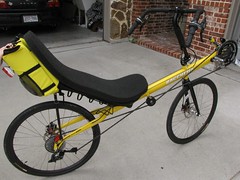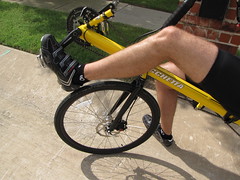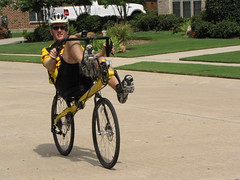It’s been about a year and a half since I bought my Bacchetta recumbent. I’ve put about a thousand miles on it so far and I still love it. I ride as much as my schedule will allow, which, unfortunately, isn’t enough.

People are always curious about the bike. Other cyclists chat me up, pedestrians shout questions at me as I ride by, and one couple in a car even pulled out a camera and snapped a bunch of pics while we sat at a light. I have seen other recumbents in the ‘hood and on large organized rides, but they are a very well kept secret around here so the bike tends to get noticed.
To celebrate my Bacchetta-versary, I’ve compiled a list of the most common questions I’ve been asked about the bike over the last year. Maybe it’ll motivate you to give one a spin the next time you’re at your local bike shop.
“What is that thing?”
It’s a recumbent bicycle. It’s called a recumbent because you ride in a reclined or semi-reclined position.
Recumbents come in all shapes and sizes. There are Long Wheel Base (LWB) models where the front wheel is in front of the pedals and Short Wheel Base (SWB) models where the front-pedals are above or in front of the front wheel. There are some with Above-Seat Steering (ASS; seriously, that’s what they call it) and Below- or Under-Seat Steering (BSS/USS). Many recumbents have a standard-sized wheel in the back and a smaller wheel in the front. Others have the same sized-wheel front and back. There are tandem recumbents. There are recumbent tricycles. There are tandem recumbent tricycles. It is unbelievable how many different styles there are, with significant differences in application (heavy loads, long-distance rides, racing), performance, and cost.

My bike is a Bacchetta Giro 26 (ba-KET-a is the Italian pronunciation, but ba-SHET-a is okay too). It’s a “high racer” with a Short Wheel Base, Above-Seat Steering, and 26 inch wheels on the front and back. The Bacchetta Giro and similar models have a unique-looking frame design: the bike essentially has only one main tube running from the rear wheel to the crank on the front-end. The word Bacchetta is actually Italian for “stick” and that name is certainly fitting when you look at the bike. I chose the Giro 26 because it is exciting to ride and looks sportier than its Long Wheel Base cousins.
“Why?”
I could try to make an argument about better efficiency or aerodynamics but that’s not why I ride it. I ride it because it’s comfortable. Try this: Sit in a comfortable chair, put your feet up, extend your arms, but keep them relaxed, and lay back a little bit. That’s what it’s like. While my upright cycling friends are crunched over, staring at their front tires, I ride reclined in comfort, my head naturally positioned to take a look around and enjoy the scenery. The other day a red-tailed hawk flew next to me for a short stretch. I don’t think I would have seen it had I been heads-down on an upright. It’s this open, laid-back style of riding that makes me want to ride as often as possible, as far as possible.
When people ask “why” the question often includes either an implied or an explicit question-within-a-question: “Is there a medical reason you ride a recumbent?” It’s funny that these bikes are so different, people assume something must have happened to you physically to persuade you to not go with an upright bike by default.
In my early teens I did long-distance rides with my father and uncle. I did Freewheel, a week-long ride across the State of Oklahoma, several times. On those rides, it wasn’t uncommon to end a 60- or 70-mile day with various sore spots–hands, ass, crotch, and sometimes knees. On Freewheel, you camp out, so heading to dinner, the shower, anywhere, usually means getting back on the bike. There were times when that was the last thing I wanted to do.
Hardcore upright cyclists will say that on a properly fitted bike with the right gear, you should be able to ride pain-free. That may be the case and to each his own. But for me, on my recumbent, pain is just not an issue. Sure, on a long ride I get tired, but nothing hurts. I’m not an athlete in any sense of the word, but I really feel like time is my only limiting factor when I’m riding my Bacchetta.
(When I first began riding the recumbent I did have some problems with foot numbness but some Specialized shoe inserts fixed that right up).
“Is it hard to ride?”
Honestly, it can take some getting used to. Starts are the biggest issue. On my Bacchetta, my pedal is 27 inches from the ground at its lowest point and 41 inches from the ground at its highest. On an upright, when you first start, your weight pushes down on the pedal and gives you enough forward momentum to get going. On a recumbent your weight gives you no vertical advantage. When starting, you have to push hard on the pedal with one foot while you get your planted foot off the ground and up to the pedal fast enough to get that second stroke in before you lose momentum and fall over. I’ve had some awkward starts and some close calls but I haven’t dumped it over yet.

Tight turns are a little exciting. Because the crank is in front of the front wheel, and because I’ve got giant size 12 feet, it is possible for my heel to come in contact with the front tire. So turns take a little bit of foresight. Even with that in mind, tight turns can be a little unsettling. I can easily turn within the width of my neighborhood street, but our neighborhood bike paths aren’t happening for me. For that reason, you may want to think twice about a recumbent if you primarily ride on tight bike paths rather than on the road.
When I first starting riding it, I found the balance to be a little twitchy. When I was really stroking, it felt like my pedaling was throwing my balance off and I had to consciously correct. Even twisting the grip shift added a wobble. Over time, my body learned to compensate automatically and now it’s a very stable, comfortable ride. When you’re on a long, flat road, maybe with a little tail wind, clipping along at about 18-20, a quiet purr coming from the wheels on the road, you’re not thinking about balance any more–you’re in some sort of recumbent Zen state.
“Is it slow/is it fast/is it hard to climb hills?”
I’m not a hardcore cyclist. I try to ride 50 miles a week, but I don’t always hit that. And I’m definitely not a fast rider. Garmin says my average speed (with stops) is about 15 mph. The Giro, a touring/commuting bike, weighs around 32 lbs, depending on seat choice and pedals. Bacchetta does offer a performance line of bikes, including the all-carbon Aero that weighs about 20 lbs and costs three times as much as the Giro. So I’m a slow rider on a heavy bike. Are you faster than me? Probably. Am I faster on my recumbent than I am on an upright? I think so, but I kind of don’t care.
Hill-climbing is a drag on a recumbent. You can’t stand up, so there’s not much to do about it other than down shift and pedal hard. At least there’s a back rest to push against. When you do make it to the top, though, the reward is oh so sweet. There’s nothing quite like flying down a hill feet first.
“Have you had any problems with it?”
The usual bike stuff. I used to throw my chain all of the time until I figured out how to adjust the derailleur. I’ve had to adjust the disc brakes a bit. From time to time, it sounds like my brake pads are dragging, but it’s intermittent. Every once in a while the chain grabs a leg hair or two, but I figure that’s a self-correcting problem.
Transporting a recumbent can be challenging. I can get it into the back of a mini-van with no problem. I’ve got a Thule roof rack with standard trays. My Bacchetta just barely fits in the tray, but the clamp that would normally hold the down tube on an upright bike doesn’t work for the Bacchetta so I bought an arm that holds the front wheel instead. I’ve seen a Thule rack with a really long tray that actually pivots to make it easier to get a long and heavy bike (like a tandem) onto the roof, which is probably what you’d need for a recumbent with a Long Wheel Base. I’ve seen recumbents on hitch- and trunk-mounted racks as well.
I bought a Garmin Edge 705 GPS cycling computer that came with a magnetic pace/speed sensor add-on. The add-on works great when the magnet on your crank arm and the magnet on your wheel spokes can pass by the same sensor. I think making that work on my Bacchetta would require some soldering, so I don’t monitor my pace and I use the GPS for speed. The included maps still made the bundle worth it, though.
“Can I ride your bike?”
If you’re thinking about buying a recumbent, you need to ride as many different styles as you can. They all feel different. And, at least when you are starting out, it helps to have someone that knows what they are doing give you some pointers and fit the bike to you.
I’m 6’1″, so I ride the “large” version of the Giro 26. Once you’ve got the right frame size, there are still several things you can tweak. The seat moves forward and backward and the recline angle is adjustable. The handle bars can be brought forward or backward and the handle bar tilt can be adjusted. Because it is so adjustable, it is a bit of a pain to let someone with different dimensions ride it. But bike shops deal with that all of the time so don’t be afraid to ask for that test ride.
“Where can I get one?”
Some bike shops specialize in recumbents. These will have the best selection and the most knowledgeable staff. For example, if you’re in the Austin area, I highly recommend a visit to Easy Street Recumbents. Mike is super friendly and very helpful. Unfortunately, there’s not a shop that specializes in recumbents here in North Texas. Shops around here tend to have a limited selection or none at all. I bought my Bacchetta at Plano Cycling and Fitness. They were great and I’d recommend them in a heartbeat.
Sometimes you can buy directly from the manufacturer. Bacchetta has that option if a dealer isn’t in your area. Also check out used bikes on Craig’s List, recumbent forums, etc.

I hate cold weather but I rode straight through winter this year. I couldn’t let it sit. I wanted to be out there, kicked back and pedaling hard. There’s something about riding that bike that I miss terribly when I don’t do it. I suspect many recumbent riders feel this way. The next time you’re about to yell, “Hey, nice bike!” at someone on a ‘bent, check to see if he isn’t already smiling.




